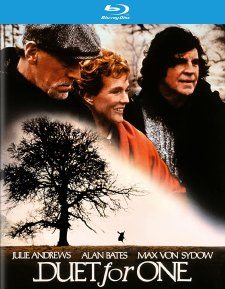Duet for One (Blu-ray Review)

Director
Andrei KonchalovskyRelease Date(s)
1986 (June 27, 2023)Studio(s)
Golan-Globus Productions/Cannon Films (Kino Lorber Studio Classics)- Film/Program Grade: B+
- Video Grade: A-
- Audio Grade: A-
- Extras Grade: B
Review
Eschewing the genre clichés of “Disease of the Week” TV-movies popular in the U.S. at the time, Duet for One (1986) is a serious drama about an acclaimed violinist suffering from multiple sclerosis. It’s a movie for adults, emphatically unsentimental, and which offers no easy answers to the complex issues it raises. It falls considerably short of greatness, but the film is a lot better than one might have expected. It’s definitely not the usual kind of thing from Cannon, the exploitation company best known for its Charles Bronson and Chuck Norris thrillers.
Duet for One began life as a 1980 play by actor-turned-playwright Tom Kempinski, written for his then-wife, actress Frances de la Tour. Based on the lives of cellist Jacqueline du Pré and her conductor husband, Daniel Barenboim, the play mirrored their lives quite closely, their real-life story dramatized again for the 1998 film Hilary and Jackie. Kempinski’s play was a “two-hander,” with de la Tour as the violinist and David de Keyser as her psychiatrist, the entire show set entirely in his office. This London production was moderately successful, prompting a Broadway opening much less so, with Anne Bancroft and Max von Sydow in the leading roles. The film version, also written by Kempinski, completely opens up the story adding many characters, presumably with incidents and relationship dynamics that in the play were only talked about by its two characters.
Wealthy and world-famous violinist Stephanie Anderson (Julie Andrews) continues to perform concerts despite advancing MS. Her alcoholic conductor-composer husband, David (Alan Bates), devoted housekeeper Sonia (Margaret Courtenay), her agent and others close to her are in a state of denial about her declining abilities, but star pupil Constantine (Rupert Everett) is quite upset when, at Stephanie’s birthday party, she struggles to get through a duet with him, which he sees as the profoundly sad, irreversible “death” of a once-great performing artist.
Stephanie reluctantly begins regularly seeing psychiatrist Dr. Louis Feldman (von Sydow, reprising his stage role) as her condition gradually worsens. All her relationships begin to suffer and change. She becomes jealous of her husband’s healthy, young assistant, Penny (Cathryn Harrison), and resentful of her husband’s drinking and stalled career ambitions, straining their marriage. Constantine, realizing Stephanie is no longer able to adequately train him, accepts a lucrative job in Las Vegas, and she deeply resents his abandoning her. Eventually, she becomes sexually involved with a straight-shooting totter (a junk man, played by Liam Neeson).
While de la Tour or another great actress roughly of that generation (Judi Dench, Helen Mirren, etc.) might have delivered a technically better performance, Julie Andrews is nonetheless most impressive as Stephanie, and that the part runs so counter to her dignified and cheery screen persona adds to its effectiveness in ways that would not have been possible with others – it’s unnerving to see Mary Poppins and Maria von Trapp in a wheelchair, mulling suicide. Amusingly, for all the fuss given Andrews’s big “reveal” in her husband Blake Edwards’ S.O.B. (1981), in Duet for One Andrews’s character appears far more explicitly and frequently nude and uses at least as much profanity.
Essentially, the film realistically follows Stephanie through the five stages of grief: denial, anger, bargaining, depression, and acceptance. Making Stephanie a world-class violinist as acclaimed as, say, Isaac Stern, both helps and hurts the story a little. It helps in the sense that it makes her MS diagnosis all the crueler, though one might reasonably argue the random cruelty of MS would be no less terrible for someone with no particular talent.
Max von Sydow, despite his greatly reduced role from the play, is superb as he almost always was, in great and terrible films. It’s a very Bergmanesque part, and von Sydow is marvelously subtle yet expressive. It’s a little disorienting to see Liam Neeson playing a lowly, uneducated junkman, dressed like Harry H. Corbett in Steptoe and Son, but he’s good in this atypical part.
It’s a difficult story to pull off, for no happy resolution is possible. The film seems to accurately dramatize the physical side of Jacqueline du Pré’s condition, a type of MS that had periods of seeming remission, allowing Stephanie to occasionally walk under her own power and even continue to play the violin for short periods long after her diagnosis. Certainly, the movie never shows her as a complete invalid, bedridden like Annette Funicello and too many others.
Kino’s Blu-ray of Duet for One, licensed from MGM, presents the film in its original 1.85:1 widescreen, the video transfer impressively sharp with excellent color and contrast. (As it should be; few prints were struck as the film was barely released at all. It certainly didn’t appeal to Cannon’s usual markets.) The DTS-HD Master Audio (originally Dolby Stereo) impresses with its classical music excerpts, though this isn’t exactly the kind of film you’d expect an aggressive soundtrack. Optional English subtitles are offered on this Region “A” disc.
Included is an appreciative audio commentary by film historian and filmmaker Daniel Kremer. A trailer is also included.
You wouldn’t be missing an essential title if you skipped Duet for One, but it’s genuinely worthwhile and most of it pays off. Recommended.
- Stuart Galbraith IV

